In the season when I visited Dagestan, the rye had already been harvested. Gone were the daisies, bellflowers, and cornflowers beneath the shy October sun, replaced by neat fields where horses graze on the last grass, aware that hay season is soon to begin.
Much has changed since Lev Tolstoy portrayed the proud and indomitable Chazdi-Murat among the thousand delicate colors of these hills. Today, those who live here proudly preserve the memory of their ancestors’ deeds, of the valor of Imam Shamil, those loyal to him, and those who felt betrayed. Memory has become history, only to turn back into memory, blending the delicate sensitivity of those who honorably defend their past with the heritage of a resilient mountain people, bound by loyalty to both God and community.
No longer flowers or thorny thistles, but men - stern yet capable of being moved by the smile of a defenseless traveler, who makes a home out of his backpack and finds enough in the pale autumn sun to continue his journey.
I must not be the first foreigner to cross these lands: the watchtowers of the ancient villages bear witness to the delicate balance that has been built over the centuries between the residents and the wayfarers. Yet, no one remembers those travelers anymore. I had the honor of being treated as the first European visitor to cross these valleys.
I wouldn’t have known how to reach this place without the guidance of a new, dear friend I met in the mountains. Nor would I have had the courage to face these days of walking without the months of travelling that came before.
Here is a brief account of my days in Dagestan, seen through the eyes of the Italian traveler I am and written as a diary to preserve my experiences.

For a living, I move around as opportunities arise. I don’t mind hitching rides; in fact, I prefer them - when available - because they give me the opportunity to chat with a well-meaning person who is sure to have something interesting to say. When there are mountains in front of me, I walk. And when there are many mountains, the journey stretches on for several days. That’s why it’s good to have a light backpack, equipped with all that is needed to be self-sufficient. The mountains of Armenia and Georgia provided excellent training for Dagestan, both physically and anthropologically. In Russia, I encountered very different souls, but let’s take it step by step:
I head up into the mountains from Grozny, the capital of Chechnya, where I find a marshrutka that takes me to Vedeno. From there, there’s no need to ask for rides: anyone who sees you walking along the road pulls over and asks where you’re headed. This way, I reach Lake Kezenoyam and then the village of Khoi.
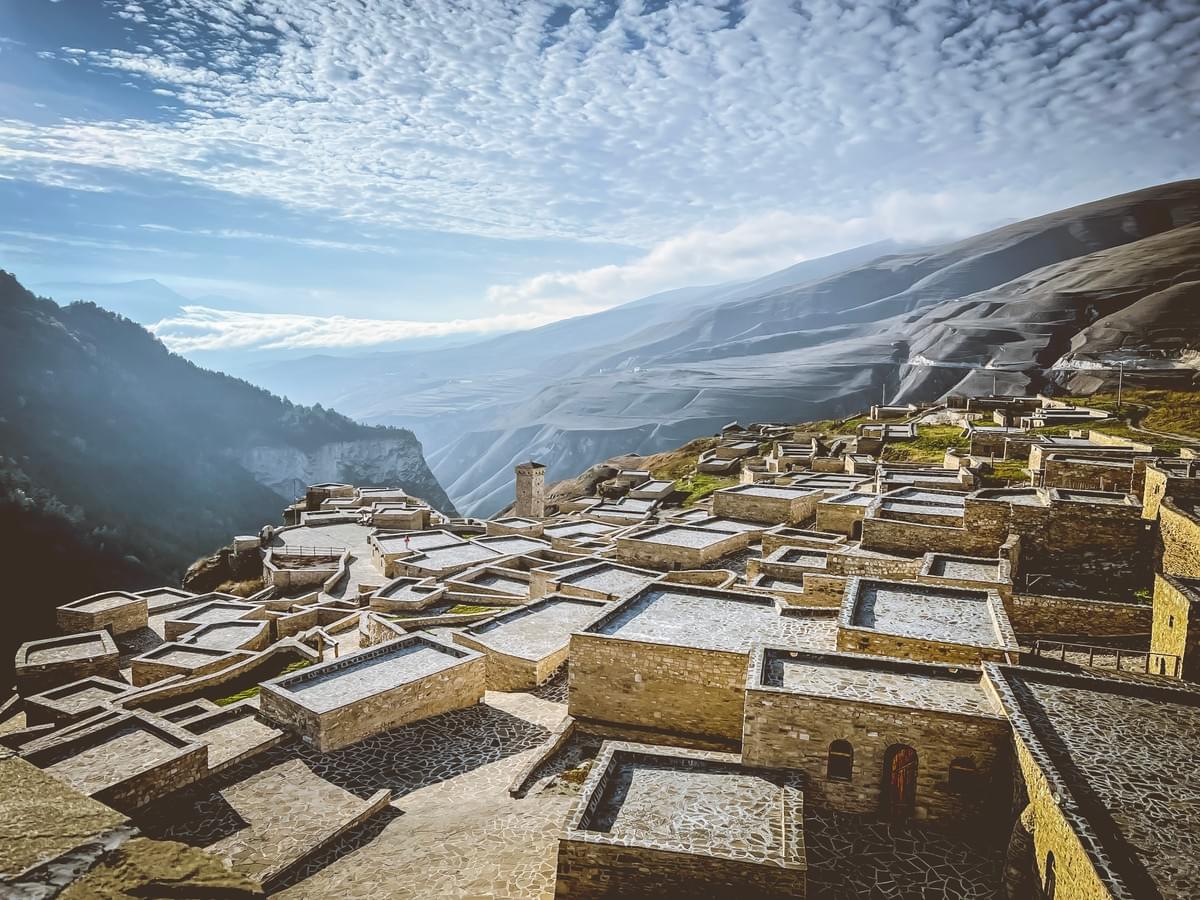
None of the people I met ever gave a lift to someone who couldn’t understand at least one of the languages they spoke, and few felt comfortable with my phone’s translator. Connection is built through gestures and smiles, sometimes an Adriano Celentano song or the name of a known soccer team.
That is, until I arrive in Botlikh, where fate offers me the best encounter I could hope for. While I’m eating in a café, someone approaches and says, “Are you a foreigner on the go? Do you want to stay at my place tonight?” It’s Vladimir, a man with the power to completely transform my experience in Dagestan.
I believe that God favors those who walk.
An afternoon stroll helps us get to know each other. Vladimir understands my time limitations and my desire for an authentic mountain experience, where nature still seems to overshadow man’s endeavors.
It just so happens that he works with a group of people who are creating a network of trails across the entire Caucasus, from the Caspian Sea to the Black Sea. Within minutes, he provides me with information I couldn’t have gathered in weeks of research. He convinces me to spend the time I have left in Dagestan on the Trans-Caucasian trail.
His advice is to set out on a route from Izano heading east, combining hitchhiking and walking to make the most of the four days I have. Of course, nothing ever goes exactly as planned: the journey starts from Karata because no car was going further. The path ascends, leading through a wide valley along a spectacular cliff. Above it rises a plateau, home to some of Dagestan’s thousand villages. People here take pride in the fact that dozens of different languages are spoken across the region. A tourist struggles to understand how that’s possible, until they reach a vantage point high above.
The density of inhabited areas is surprising to anyone accustomed to spending time in high mountains territories. No matter how rugged the terrain may seem, behind that rocky ridge, there will always be a village. And then another, and yet another!
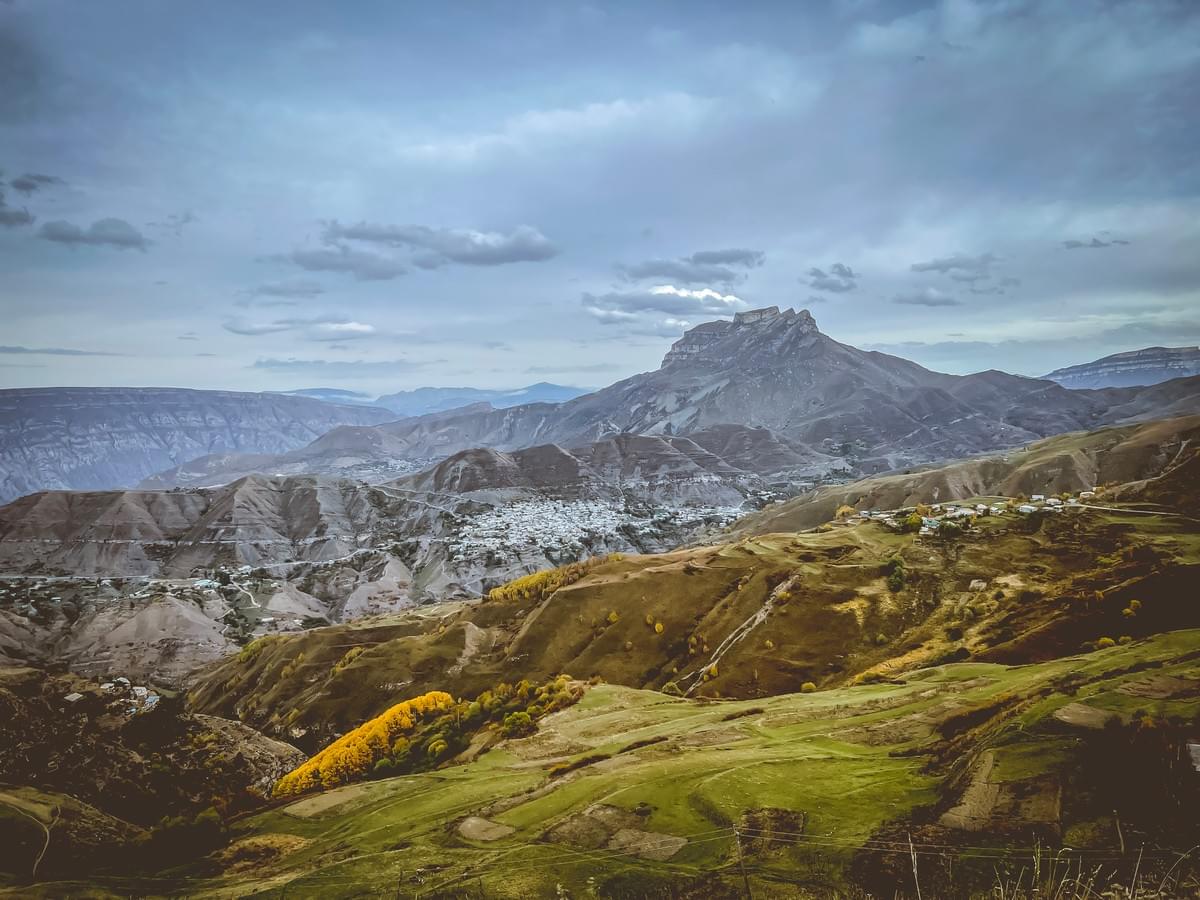
I arrive in Izano around lunchtime, just as Malamagomed—the resident of the first house I come across—is heading out to check on his cows. “What are you doing, walking? Come and have some tea!”
That tea quickly turns into lunch, during which he and his cousin give me some valuable advice: “It’s a beautiful day, why don’t you go up to the plateau? The view will be amazing, and after two and a half hours of walking, there’s a village where someone will surely host you for the night.”
From Izano, there’s a small path that lets you ascend to the imposing cliff without needing to climb any part of it: left, right, left - Dagzimurad traces the route on the ground with a stick to help me understand.
And so, I begin the ascent, moving between rocky walls that get lower and narrower, certain that the top is near.

Right where the gorge becomes particularly narrow, there’s a gate blocking the path - a true cultural barrier. In Italy, this structure would be intended to prevent people from passing. I would later discover that in Dagestan, this concept doesn’t exist: people’s only concern is to prevent animals from reaching areas belonging to other shepherds.
I behave like a sheep and don’t go through the shepherd’s gate.
As the sun is nearly behind the mountains, I manage to reach a gentle clearing where I can set up my tent - a perfect spot to savor the climb that awaits me the next day.
Tent, thermal blanket, sleeping bag—all ready for the night. I head out to gather wood for a fire. I return with a few branches found near the stream and, in front of my tent, Bashir is waiting for me. He saw me from afar and, curious, decided to come over and see what was going on. “Tonight, you’ll be my guest. I’ll cook avar khinkal for you, and you’ll tell me what you’re doing here. Come with me to my tent! We’ll have fun.”
And that’s exactly what happened—I hastily take down my camp and follow him.

Bashir is a shepherd of goats and sheep, living in his tent until the cold forces him to leave—which, according to his predictions, was just a few days away. Of Avar culture and heritage, Bashir doesn’t bother with milking his animals: he doesn’t select his flock based on the sex of the newborns. For him it’s all about the meat, and apparently, he knows how to handle it very well.
He pulls out a large knife and a few kilos of already-skinned sheep’s back. We’ll cut pieces of meat the width of a vertebra and set them to boil in a large pot. While they cook, we smoke a hookah. He prepares balls of flour, salt, and water as I watch his animals arrange themselves neatly in the most sheltered part of the valley, without anyone giving them any orders. The grass inside Bashir’s large tent is still green, even though it’s been set up for several months. There is a small bed in the center, and just in front, the ground has been smoothed out with some flat stones and covered with a prayer rug, facing the Kaaba (Mecca).
“I hope you’re not afraid of spiders,” he says, as he takes the thin mat from his bed and lays it on the ground for me. This will be my sleeping place for the night. We fall asleep drinking the broth in which the vertebrae and flour balls were cooked. I’d never tried a protein-and-carb “tea” before, but after this experience, I’d gladly order it in a restaurant.
The rainy night is followed by a golden dawn, and I set out early, grinning from ear to ear, unable to shake off the smile. Climbing and sweating, sweating and smoking. A bad habit, without a doubt, but it comes with it an anthropological perk: offering an Italian cigarette in Dagestan is an excellent way to make a friend.
As you move from one valley to another, the waters of the streams taste different. By mid-October, there’s no snow on the mountain peaks, and it’s clear that the water flows are at their lowest. The streams rest in wide beds, hinting at a much more abundant flow during spring.
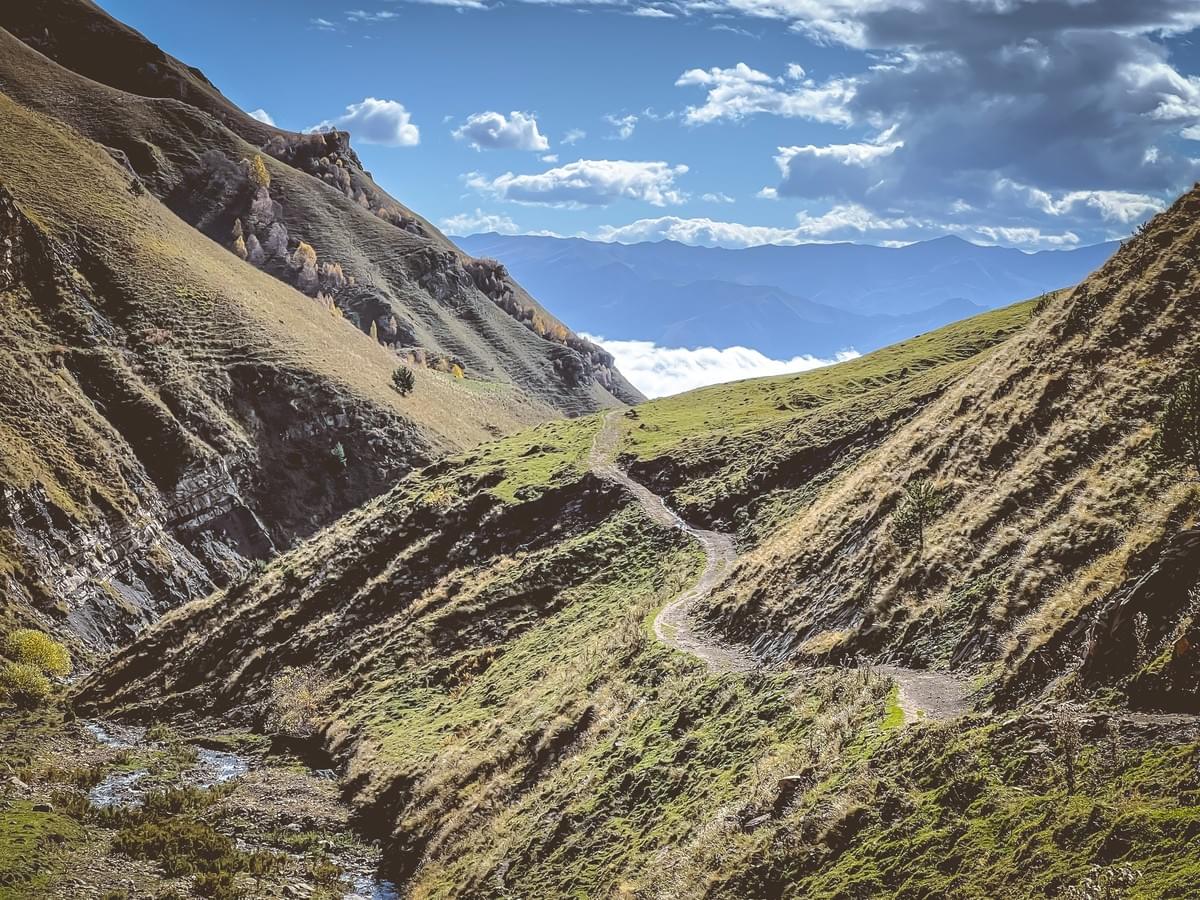
I continue toward Assab: once past the pass, the path quickly turns into a small road, and the trees once again dominate the landscape. In Assab, I find a few people and a lot of humanity: the concentration of tea in my body reaches alarming levels. I leave the village, and - without making any gesture - a car stops for me. Mohammed is driving, offering me a ride toward Khalid. Everything goes according to plan as we speed down like lightning bolts, listening to his favorite music: Spanish techno (he was grateful I recognized the language, as he had been wondering for some time where that music came from).
I ask him to drop me off at a café for some hot soup, which turns out to be a rather naive move. In Khalid, there’s a police station, and the officers clearly are not used to seeing foreigners walking around with a large backpack.
Around lunchtime, some of them come to eat at the same café I’ve chosen, dining at a table hidden behind two large curtains. They overhear me talking to the cook, and as soon as they hear me say, “I’m Italian,” one of them leaves the officers’ corner and comes over to ask for my documents. They let me eat in peace, but afterward, I spend three hours at the station undergoing a meticulous check—enough to ruin my afternoon hiking plans.
So, I’ll have to reach the town of Goor by hitchhiking, or I’ll end up camping in the canyon instead of on the plateau. I don’t even have time to complain to myself about what happened before a car stops without me making any sign. A kind family takes me to Goor in time to see the ancient town and the beautiful rural mosque before the sun sets.
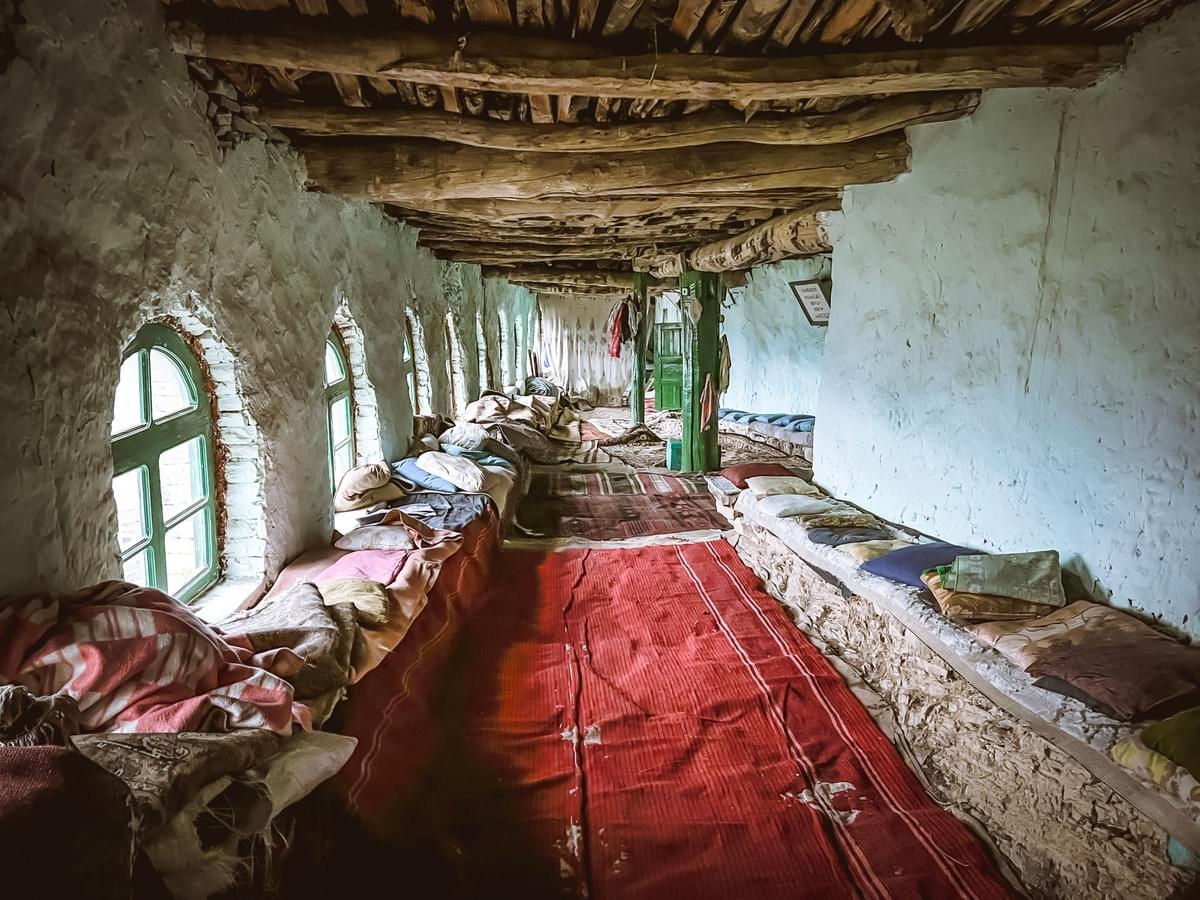
Some young men see me setting up my tent in the strong wind and suggest I head down into town: there’s a mosque there where I might be able to spend the night. By now, it’s dark, and all the villagers are keeping warm inside their homes.
I enter the mosque and I find a young man playing on his phone. I will later recognize his voice singing from the minaret speakers, both that evening and again in the morning. He tells me that I was misinformed and that the mufti won’t allow me to sleep inside. However, since it’s late, they’ll let me set up my tent right outside.
A freezing night follows.
By 7am, I pack everything up and am on my way, facing the longest day of walking — from Goor to Teletl: 25 kilometers of trail and 1,500 meters of elevation gain.
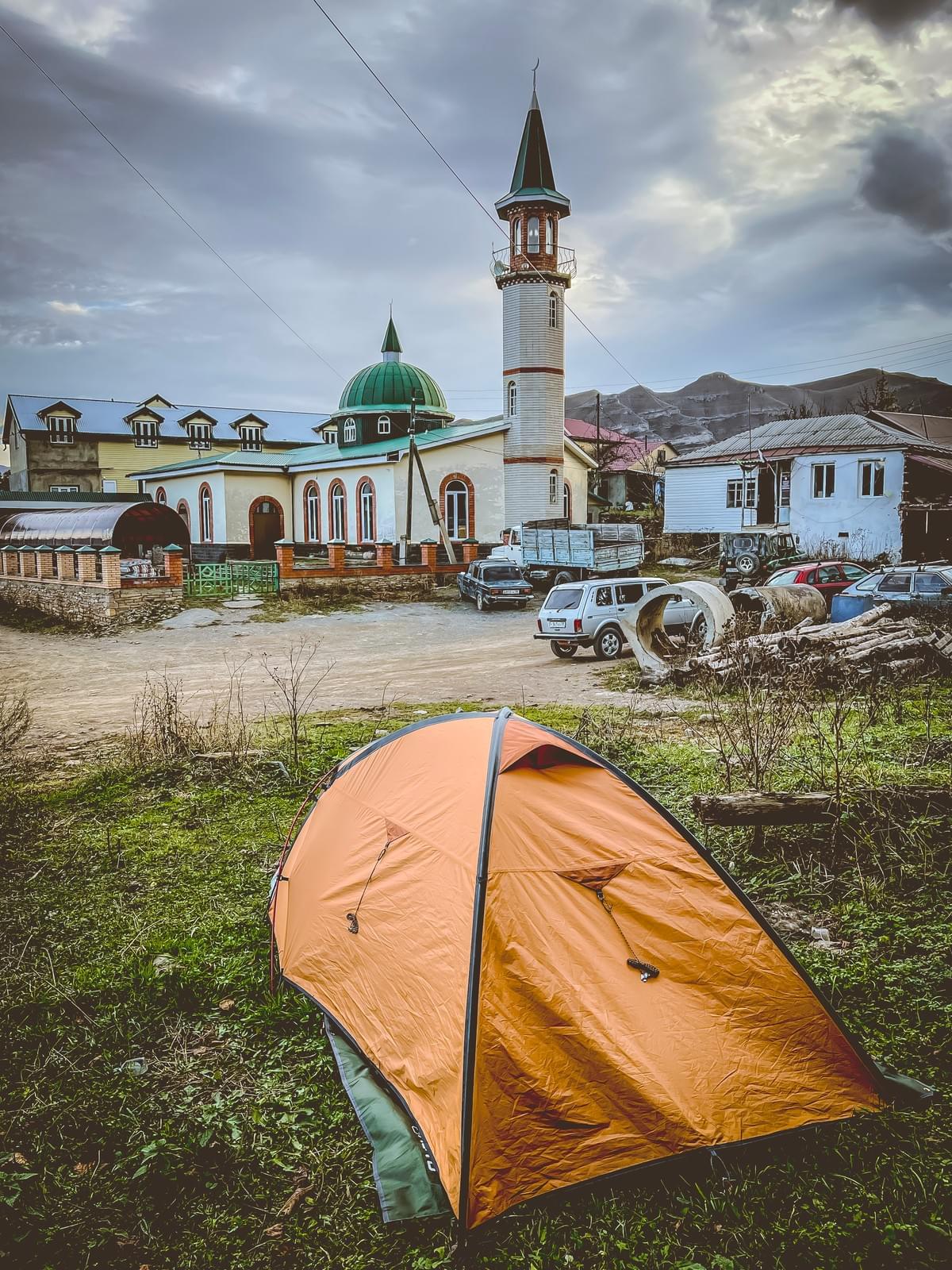
From the conifer forest the trail ascends into the vast grasslands typical of the high Dagestani mountains, dotted with the ruins of shepherd shelters from long-gone times.
You can’t shake the feeling that you’re being watched. The large eagles circling overhead could easily make a quick meal of me - if only they knew how to work together. The path becomes increasingly narrow, eventually merging with a stream where it’s impossible to avoid getting your feet wet. From there, the climb eases, and the most thrilling part of this leg begins.
Soon, I reach the village of Ziurib, perched in a convenient position to observe movements in both valleys on either side. Narrow, hidden paths between the balconies of houses lead to the top—if you’re willing to pass through nettles and thorny plants. This village is seeing its first concrete being poured in front of the mosque right now. They’ve never seen a foreigner before, or at least, that’s what I was told.
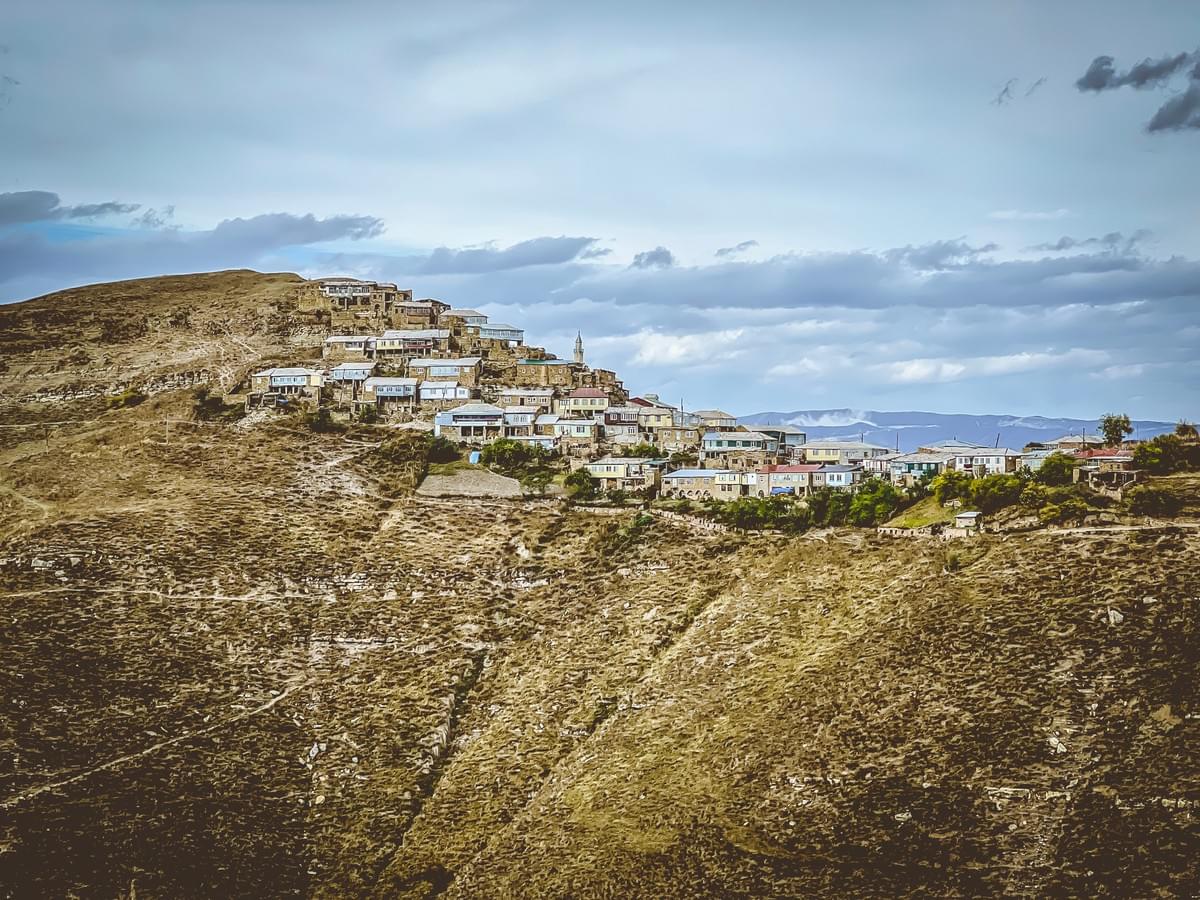
From above, you can see Teletl, but the terrain’s orography forces a winding route through the valleys carved out by the numerous streams that characterize these mountains. These streams support the presence of many isolated houses, with foundations made of beautiful stone arches used to shelter straw and dung from the harsh winter weather.
Some women are working in the fields, but here—unlike in the other villages—they become embarrassed when I greet them and often turn away. Without realizing it, I’ve stumbled upon the most religiously conservative settlement in the area. The numerous ruined houses suggest that the village is losing inhabitants, yet it’s impossible not to be captivated by the careful arrangement of buildings along the cliffside, making Teletl the most interesting cluster of houses I’ve encountered so far.
I continue on to a small shop, where I find less than I’d hoped for. I try to be friendly with the few (male) locals who respond to my greetings, but with little success. One man advises me to head back into nature and find a place to set up my tent before nightfall. Undeterred, I look for another small shop to complete my supplies for the next day. It’s impossible to find cheese here, despite the number of cows I’ve seen along the way.
The narrow main road is flat and runs through the village lengthwise. A few parallel alleyways allow the settlement to expand vertically, connected by narrow, almost hidden paths just wide enough for a donkey. Perhaps the donkeys that are wider than the paths remain isolated and are unable to move through the town. I encounter many of them, all eagerly munching on the straw left for them in the house entryways.
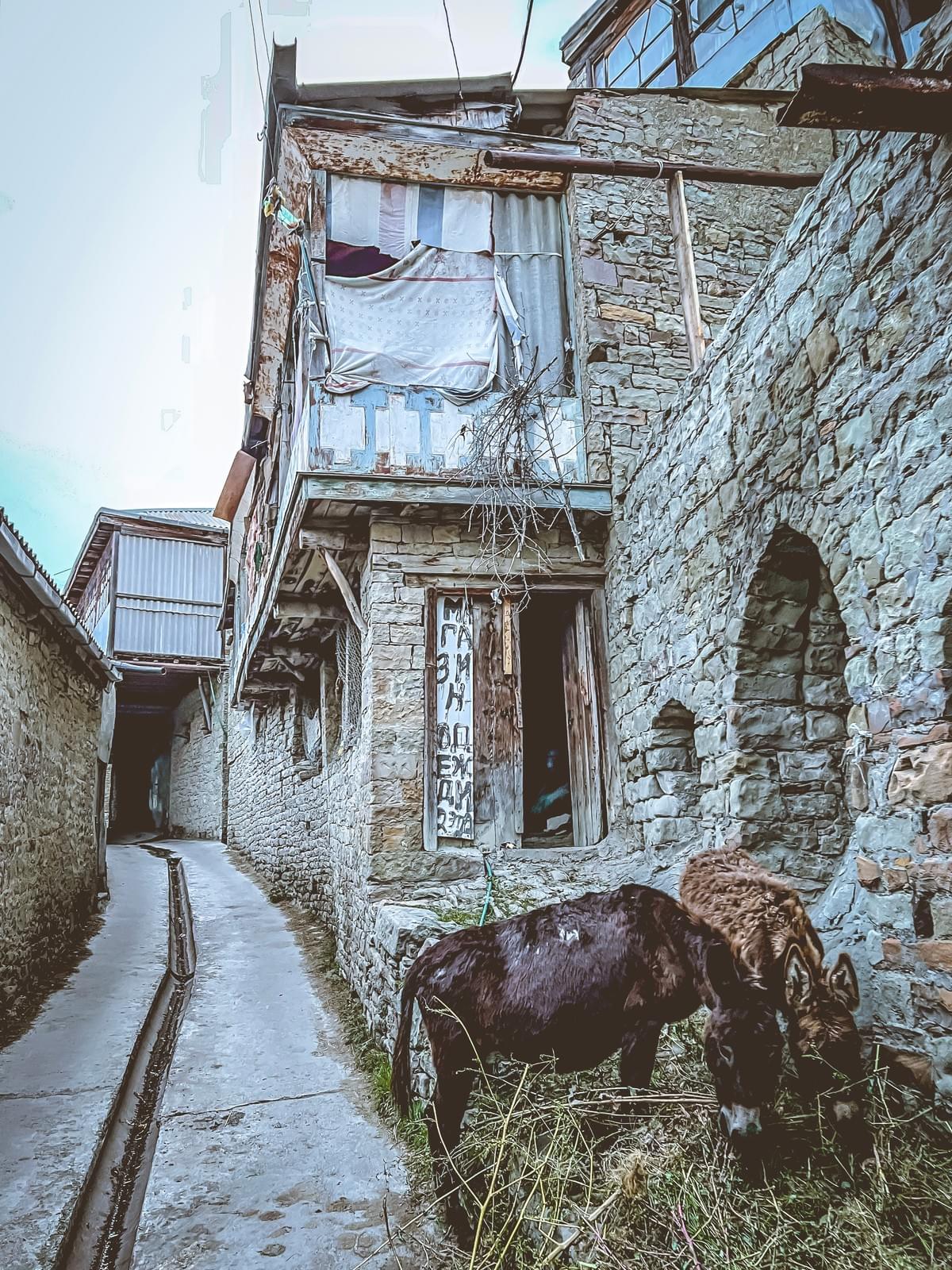
There is a mosque at both the beginning and the end of the village, both located on the main road. After a brief visit, I approach one of them, hoping it might end up like the previous night. I open the door.
“As-salamu ‘alaykum. I’m looking for a flat place to set up my tent. It doesn’t seem like there are many around the village. Can you recommend one?”
“Young man, why don’t you go into nature for those things?”
“I needed to buy food, and then night fell.”
“Set up the tent behind the mosque, and tomorrow morning you’ll leave early.”
And so it’s done. I choose the most hidden spot and set up my tent.
As soon as I finish setting everything up, a man approaches and says, “Come with me, I’ll take you to my house.”
He’s a schoolteacher, teaching history and geography, but he loves discussing politics - at least with me. He puts me in his study and assures that we won’t be bothering each other. He doesn’t seem all that happy to have me there, but since the villagers don’t like people sleeping outdoors, he preferred to host me.
In reality, Aabdurahman softens as soon as I tell him that I, too, am a teacher: “I’m on my way to a school in Kyrgyzstan where I’ll be teaching English for the winter. I go wherever I think I’m needed, as a volunteer.”
A big smile spreads across his face, and we start an intense discussion about the role of teachers in society. The conversation soon drifts to politics: Aabdurahman feels the need to explain that Dagestanis are an integral part of Russian society, proud to belong to a great country, and they would like to have friendly relations with Europe; but Europe is in the wrong, so for now that’s not possible.
Instead of delving into the details, I want to highlight one topic in our conversation that profoundly surprised me.
Throughout my journey here, I had always encountered very negative opinions about neighboring peoples. For example, the northern Turks have a deep disdain for the Kurds; they advised me to watch my wallet once I crossed into Georgia and still harbored resentment over the Russian invasion of 1916. In Georgia, similarly, the Turks were considered dishonest, and they were glad my experience there had gone well. Armenians were angry with almost everyone around them, listing monasteries or Armenian settlements now under the control of other governments. Similarly, in northern Iran, Armenian claims were seen as a danger, likely to spark conflict, and there was a strong dislike of the control the “Persians” had over an area inhabited by Azeris—who, however, identify themselves as “Turks.”
In contrast, Aabdurahman considers Azeris and Georgians “Caucasian brothers” and proudly told me that in northern Iran, people remember their encounter with the Soviets positively (something I also heard in Urmia and Tabriz, in Iran). Here, it seems that the sense of belonging to a community isn’t tainted by the same exclusivity or superiority. Being proud to be part of a Great Country that respects the minority to which one belongs seems to grant these small communities a peace I hadn’t encountered before.
After this experience, I notice for the first time that the rivers further down the valley have names. They mark a boundary and require a bridge—thus an authority—for people to cross. None of this makes sense, however, in the thousand high-mountain villages.
I descend into the valley feeling lighter, as if a mule from Teletl had eaten away the prejudice that weighed on me more than I realized, or as if some of the eagle feathers I found along my path were in harmony with my movements.
I will bid farewell to the mountains by attending the funeral of an elderly woman in Gogotl. My time here is up, and I feel the desire to deepen my understanding of this Great Country that makes space for every small community within it.
A new journey begins with different means, heading north. But that, as they say, will be another story.


